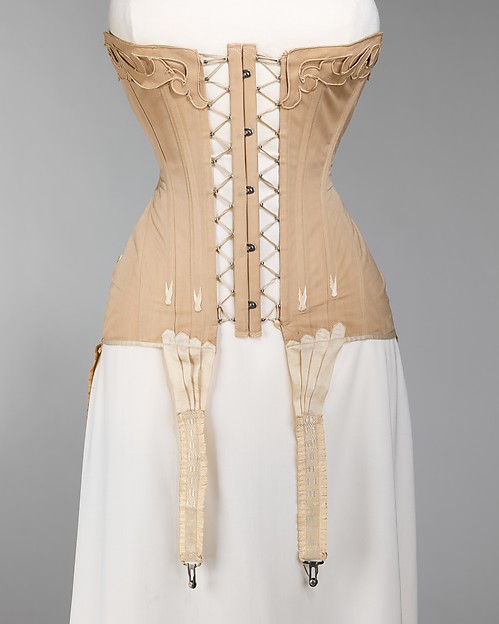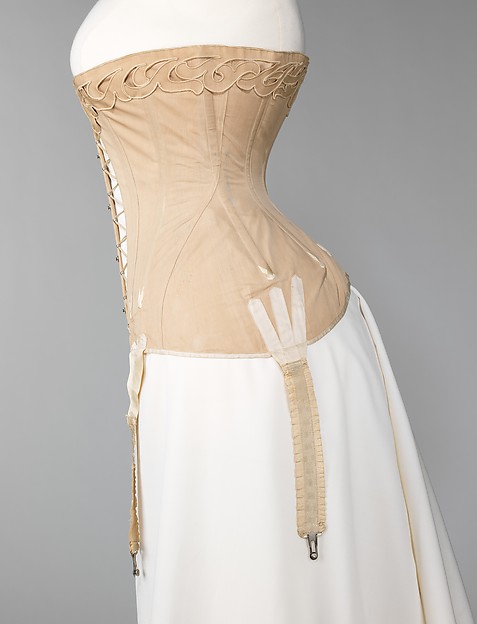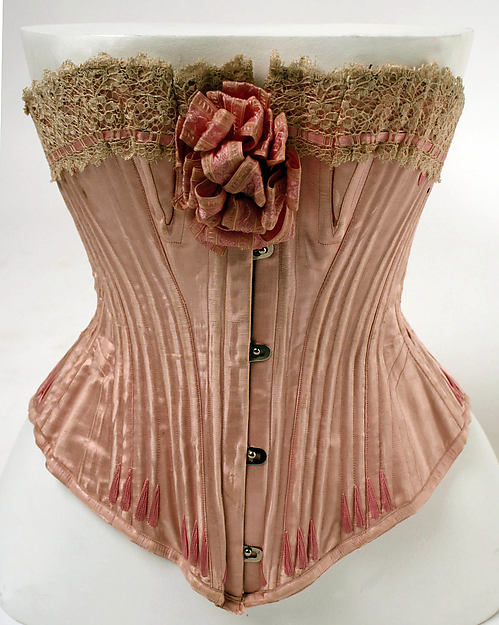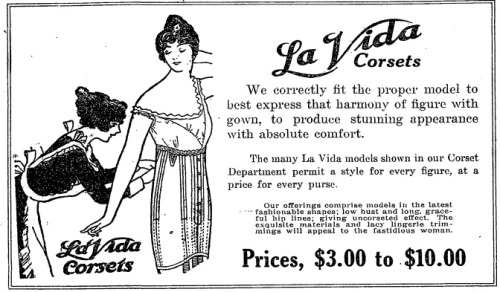Although popular in the Victorian era, the curved busk began
to be thought of as unhealthy, and along with “health corsets” (mentioned in an
earlier post), a straighter busk came into use during the end of the 1890’s.
 |
| Corset Ad c. 1903 |
This
new straight busk did not press against the internal organs quite as much, and
gave a more upright posture.
  |
| French cotton, metal, elastic, bone and silk corset c. 1905 source |
After
1907 the wasp waist became less acute with
the introduction of the “Directoire” style in dress by Paul
Poiret, inspired by post French Revolution fashions, and high waists and long
slim figures were fashionable once again.
Corsets therefore
became straighter and longer, starting
just above the waist to well down the thighs almost to the knees, resulting in
a long slim silhouette. They
no longer came up to support the breasts,
although a full bust was still fashionable.
The new corsets still used a straight busk and had a
straight front but their function was not to compress the waist but to minimize
the stomach and hips. The look was no
longer the hourglass - waist, stomach and hip measurements had to be more or
less equal. Some early long line corsets were very long,
often reaching near the knees, which made sitting down quite difficult. These corsets often
had elastic gusset inserts which were supposed to increase comfort level and
allow bending, one hopes. There were also deep hip gores on the corset
to allow for the natural shift backwards of the hips and buttocks. Many corsets
now also had stocking suspenders attached to them, rather than separate
garters.


This new straight fronted corset relied on clever cutting
techniques, such as cutting on the bias, rather than boning, to give the corset a shape
it never had before. Some boning was
still used, but it had to be long and flat, and on average most corsets only
had about 12- 20 bones, spaced evenly around the body, and it not extend the
whole length of the corset. Whalebone
was also becoming rare and very expensive at this time, and steel was often
used where boning was needed. Warner’s
introduced “Rust Proof” steels (which were watch-springs covered in paper) and
the Spirella company introduced the spiral bone (which is still used in corsets
today).
 |
| French silk corset c. 1905 source |
Traditional corset fabrics such
as coutil, cotton and linen were used, but damasks and silk became more popular,
and the famous corset colour, Tea Rose
pink, was introduced. Trimming was used,
but was usually in the form of just a little ribbon around the top, although some, like the one above were more decorative.
 |
| Ribbon waist cincher in Tea Rose Pink c.1908 source |
For sporting or active wear, and also for sleeping in, shorter
corsets made out of strips of ribbon (ribbon corsets and waist cincher corsets)
became popular. Once again corsets became the symbol of wealth,
as the longer corsets were difficult to function in and to put on, and wearers
really needed a servant to help them dress and complete everyday tasks.

As the bust was no longer supported by the corset, a
bust bodice became essential. Simple darted bands a few inches wide that
covered the nipples ,with fine straps, were worn by about 1914, and elastic belts were also popular with younger
women when they were active during the First World War. Several countries
maintain that they produced the first version of the bra , but Mary Phelps Jacobs patented her 1908 invention
in 1914, under the name of Caresse Crosby (before selling it to Warners).


By 1918,
once the First World War was over, women's attitudes and fashions shifted.
There could be no return to the heavily boned corset as it had been in former
times, and a shorter and a lighter boned model of corset would start to
replace it. This new style of corset
ended just above waist level and although it still came low down onto the hips,
paving the way for girdles and the changing role of woman.
  |
| American cotton, bone, metal, elastic corsets c 1915 and 1917 source |
 |
| source |
I think the late Victorian and
early Edwardian periods are my favourite for corsets. What about you?
Next I’ll look at some of my
favourite dresses and accessories from those periods, including parasols. Meanwhile, if you want to make you own corset, have a look at this site:

Deb xx

Your post is quite relevant to what I am looking up these days. Thank you for sharing and greetings from Montreal.
ReplyDeleteShort Sale Florida
I have found these so interesting, thank you!
ReplyDeleteLove Lil
This is so interesting, I'm so glad you're doing these posts!! How women use to wear these day in day out I have no clue! XxxX http://thesecondhandrose.blogspot.co.uk
ReplyDelete